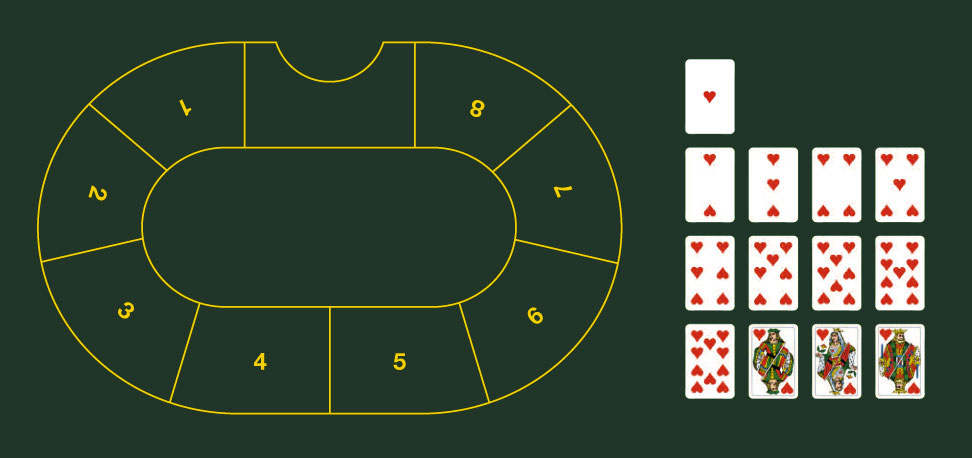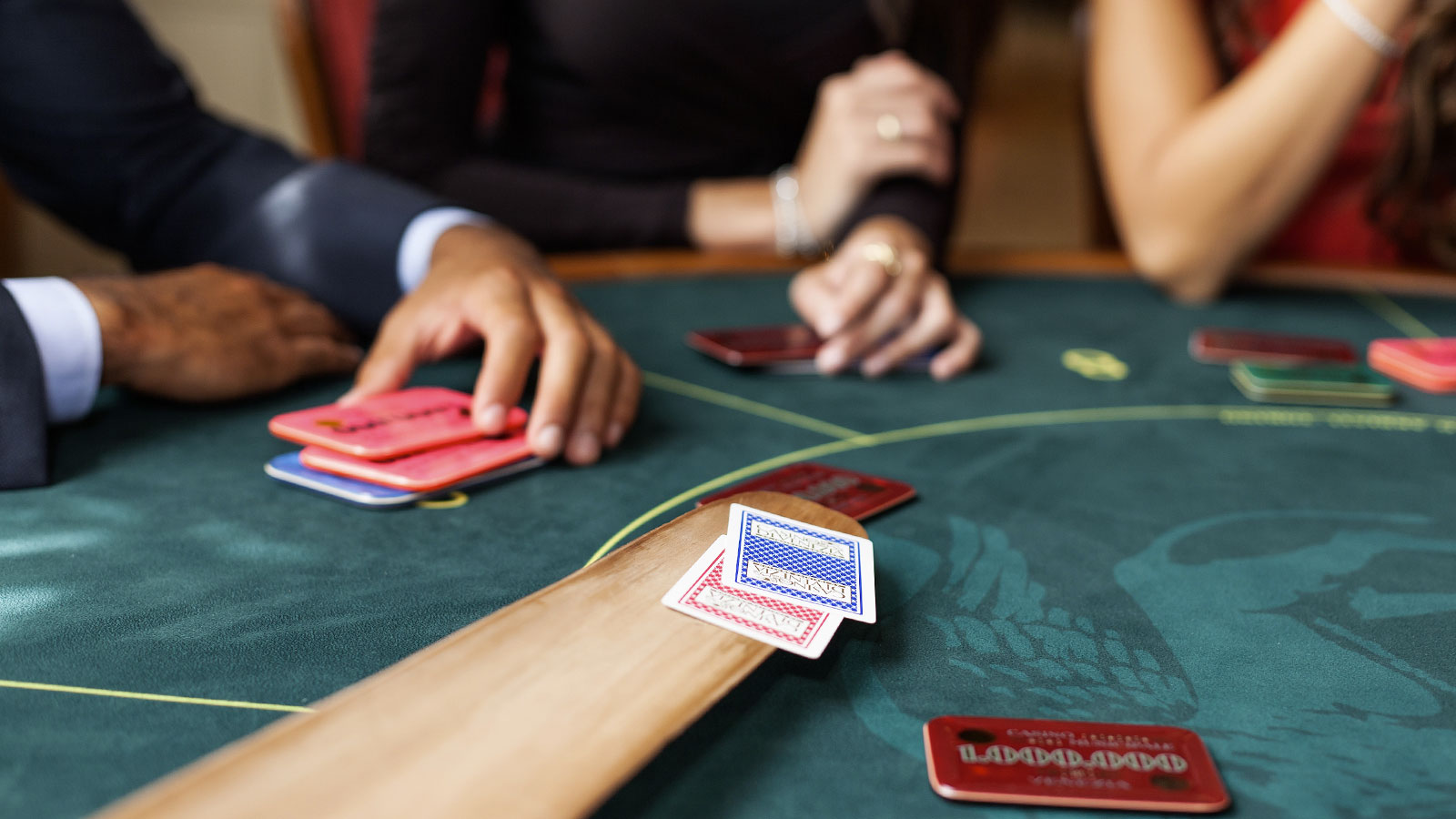CHEMIN DE FER
Beautiful, magical and absorbing, Chemin de Fer has, since time immemorial, excited the greatest players in the world and in allcasinos. It would seem that its origins date back to medieval times when a game called “Baccarà” was played with tarots that were considered magic, so much so that they were decorated by famous artists and used as tools of divination.

Chemin de fer is the classic card game. Glamorous, magical and exciting, it is a game that has always thrilled the greatest gamblers the world over.
It seems that the origins of this game date back to the medieval period, when a game called “Baccarat” was played with Tarot cards. These special cards were considered magical and were often decorated by famous artists and used to tell fortunes.
The game reached France at the beginning of the sixteenth century, where before being introduced to the casinos, it first enjoyed a lengthy period as an exclusive game played only by the nobility.
The name of the game, “Chemin de Fer”, which means railway in French, comes from the fact that the grid drawn on the green baize Baccarat table resembles railway lines and the card shoe or sabot (a card holder that distributes the cards and is passed round the table from player to player) looks like a small train.
Casinó di Venezia holds a series of Chemin de Fer tournaments with prestigious prizes in the most exclusive salons of its elegant renaissance palazzo, Ca’ Vendramin Calergi
The table is kidney-shaped and seats nine people. The table has eight boxes drawn on it for the players, plus a special recess, which is where the Croupier sits.
In the centre of the table there are three baskets. The main, largest one called the “sibyl” is where used cards are put at the end of every coup (round). The two other openings, on the right and left of the sibyl are for tips. There is a fourth slot on the right of the Croupier, for the chips that constitute the Casino’s commission as we will see later.
A steward called the “Changeur” always stands near the table.
Their job is to assist the Croupier by helping to change up chips and banknotes. To do this the Changeur is entrusted with a stock of Casino chips.
The game is played with six decks of fifty-two cards (six jeux de 52 cartes): three decks with card backs of one colour and three decks with card backs of a different colour. This makes a total of 312 cards.
The aim of the game is to reach a score of 9 points or as near to 9 as possible by adding together the values of the two or three cards drawn.
The lowest score is zero (Baccarat). Aces count as one point, the picture cards and 10s count as zero and the other cards are worth the value shown on them.
The end score is obtaining by adding together the value of the cards minus 10 wherever possible (8 + 7 = 15 - 10 = 5).
The players (jouers) play against each other, not against the Casino, and the croupier directs play only, ensuring that the rules are observed and taking a 5% (cagnotte) commission of any sums the banker (le banquier) wins for the Casino.
To begin the game at least six players must be sitting at the table, which has eight places. Players who wish to take a place at the table must first ask the Game Supervisor. Players who are standing may also take part in the game within the prescribed limits. One of these limits is that they may only stake the box in front of them and they may not change position during a hand.
The game begins with the player sitting at box no. 1 (banker), who lays a stake equal or higher than the minimum table limit specified by the Game Supervisor.
If the banker wins, he may continue, but to stay in the game, he must bet the entire stake (original bet + win).
If, on the other hand, the banker (la banque) loses or retires after at least one valid round (passes the bank on), the hand passes onto the next player (from left to right). A hand is a sequence of
one or more rounds (coups).
At each round the banker takes four cards from the sabot, the first and third are for the “punter” (le ponte, i.e. the other player), the second and fourth are for the bank.
When the cards have been dealt the punter looks at his cards without showing them and decides whether or not to call for a third card by saying “card” or “no card” (carte ou pas de carte). If the punter has scored 8 or 9, he must announce the number (abatage) and turn his cards over.
If this happens the banker cannot draw a third card and his score is based on the two cards already dealt.
After the “punter” has made his play, the banker turns his cards over and draws another card or stands.
The player with the highest score wins, i.e. the player whose card score is 9 or nearest to 9.
If the banker and the punter draw, the round is considered invalid (égalité - le coup est nul).
If the “punter” loses, he may keep playing by announcing “banco” (banco suivi) again. This excludes the other players from the round.
There are usually only three stakes made in this game:
• Bank only
The punter plays alone against the banker
• Bank with table
The punter bets half the sum staked by the banker
• Individual player stakes
The stakes of the various players play together to cover the bank without exceeding it. With this stake the punters’ cards are dealt to the player who has staked the highest sum.
Players who wish to take part in a hand must place a stake in front of their own box beyond the dividing line. Stakes placed over the line are worth half their value unless the player declares otherwise. The value of the stakes laid by the players standing up are exactly the same as those laid by the players sitting down.
Players are free to abide by or ignore the table shown below, known as the “Rule Table”. Those who wish to abide by the Rule Table must tell the Croupier who in turn informs the other players.
The Croupier must always indicate “Rule Table” players as if there is a mistake the customer is safeguarded by the regulations, which state that any rounds that do not comply must be reconstructed by the Game steward according to the Rule Table.
• The Game Supervisor reserves the right to form tables “at his/her discretion” by assigning places to players who have reserved them.
• Players may not occupy more than one place, either at the same table or other tables.
• There are nine places reserved for players at the Grand Table.
• Only the Game Steward can close betting using the customary phrase, ”Rien ne va plus” and after this players may not change their stakes. All stakes must be laid individually and shall be considered valid only if they consist of chips belonging to the Casino or Euros. Any stakes placed after ”Rien ne va plus” has been called will not be accepted.
• If the banker decides to withdraw and “pass the deal”, the game steward offers it to any of the players who are willing to start the bank “all’altezza” (i.e. with the same amount at which it stood when the last banker retired). The steward offers the bank in rotation to the players sitting at the table, starting with the player on the right of the last banker. If none of the seated players accept, the bank is then offered to the standing player that “speaks first”.
• If no one accepts the bank “all’altezza” it is put up for auction and passed onto the player who bids the most. No distinction is made between the players sitting down and standing up. If, however, two or more players bid the same amount, players who are seated take precedence.
• Any cards that appear face up in the sabot are automatically null and void and once a card has left the sabot it may not be put back inside it. It is strictly forbidden to look at the cards as they are being removed from the sabot.
• Players sitting or standing at the table and anyone who is watching are kindly asked not to talk or comment aloud on the progress of the game.
• Any unclaimed stakes or wins shall be raked in by the Game Supervisor and put to one side in compliance with the procedures laid down by the Gaming Management.
• The Game Supervisor has the right to change the minimum stake limits at any time, even during a game, by informing the players verbally.
• It is the Management’s right to suspend play at any time.
• Any dispute that may arise will be settled without right of appeal by the Gaming Management.

